A classic Italian beef ragu that's easy and packed full of flavour! This ground beef ragu is made using only a few simple ingredients and can be used in so many ways. Toss it with fresh tagliatelle pasta, make it into lasagne with bechamel sauce or use it as a filling for homemade ravioli for a truly authentic Italian meal. Find step by step photos and instructions below.
Classic beef ragu is one of my all-time favourite Italian foods, it's very simple, easy to put together and incredibly delicious!
It can simmer away on a Sunday afternoon while you relax and sip on a glass of wine before tossing it with your favourite pasta. Proper comfort food that's made to be enjoyed with the whole family.
The Difference between Ragu and Bolognese
Ragu depending on where you are in the world is a meat-based sauce usually consisting of finely chopped vegetables, ground meat and cooked in a liquid such as wine, tomatoes or stock.
There are hundreds of different types of ragu all containing different meats or vegetables like our Venetian Duck Ragu (perfect for special occasions) and our Sausage Ragu which is super easy!
Bolognese on the other hand actually means something originating from Bologna, Emilia Romagna and their classic ragu alla bolognese (ragu from Bologna) has been a little lost in translation over the years.
It's very similar to this one although is often made with white wine and sometimes milk which is thought to tenderise the meat.
It's also traditionally served with tagliatelle pasta and never spaghetti which is why you'll hear Italians say that Spaghetti Bolognese doesn't exist.
Slow Cooked Beef Ragu
This Italian ragu is slow-cooked because it needs time to develop all the incredible flavours BUT it's not as time-consuming as you may think.
Because this classic beef ragu recipe is made with ground beef and pork it doesn't need as much time as a big chunk of meat would to break down and tenderise.
This ragu needs a minimum of 2.5 hours cooking time so you can easily make it only a few hours before serving it.
That being said the longer it has to simmer the better the flavour will be, just remember that you'll need to keep topping up with water or stock to stop it reducing too much.
Never Miss A Recipe!
Get all the latest recipes and Italian content sent straight to your inbox (plus our top 10 Italian cooking secrets!)
How To Make Beef Ragu - Step By Step
The ragu starts like a lot of Italian sauces, stews and soups, with Il Soffritto.
Il Soffritto is very simply, finely chopped carrot, celery and white onion sauteed slowly with a little olive oil for about 10 minutes until soft but not browned.
This adds an incredible depth of flavour to many dishes and can even be made in advance to add into weeknight meals for an extra flavour punch.
How To Make Il Soffritto
Finely chop equal amounts of carrot, white onion and celery. To make Italian beef ragu, I use 1 carrot, 1 celery stick and 1 white onion.
Saute the chopped veggies in a large pan with a little olive oil. The key is to saute the veg slowly on a low/medium heat so they soften and release all the delicious flavours without browning or burning (around 7-8 minutes, photo 1)
Once the vegetables are soft add the ground beef and pork (mince) to the pan and brown then add the red wine and continue to cook until the wine has reduced by half.
Once the wine has reduced add the tomato passata/pureed tomatoes and half of the beef stock. Stir the sauce and let it simmer on a low heat for 2 and a half hours topping up the rest of the stock as it reduces.
Tip: Remeber to check on the ragu every now and then to stir it and add extra stock or water if needed.
How to get the BEST Flavour
An important tip about making this classic recipe is to make sure you use equal amounts of beef and pork.
Beef is a lean meat whereas pork is much sweeter and fattier and adds a tonne of extra flavour to a ragu.
Trust me, when you try using 50% beef and pork instead of all beef you'll notice a huge difference in flavour and that's exactly how it's made in Italy.
Ways to Use Beef Ragu & Serving Suggestions
This authentic beef ragu is perfect tossed with tagliatelle pasta (or any pasta of choice) made into a classic lasagne with a cheesy white sauce or stuffed into cannelloni or ravioli (simply replace the original fillings in these recipes for ragu).
You can even serve it how it is over creamy polenta with lashings of parmesan cheese and a glass of red wine.
It's comfort food at it's best and can be used in so many different ways you'll never get bored!
How to Store Leftover Beef Ragu
Like most stews or slow cooked sauces, they taste even better the next day because the flavours have had a long time to develop.
You can store leftovers in the fridge for up to 3-4 days. You may need to loosen it by adding a little water or stock when reheating and make sure it's piping hot all the way through before serving.
You can also freeze this beef ragu, it freezes perfectly and it's a great way for prepping ahead.
Just freeze in suitable containers then thaw completely before reheating.
Top Tips for Making the Very Best Beef Ragu
- Don't rush the soffritto or you won't get the real depth of flavour.
- Make sure to use 50/50 ground beef and pork.
- Use high-quality passata (sieved tomatoes) as cheaper brands can be very acidic.
- Use a red wine that's good enough to drink and never use cooking wine.
- Try to use the highest quality beef stock or broth you can find if not homemade. This sauce is super simple so high-quality ingredients are important.
- If serving the traditional way with tagliatelle pasta then boil the pasta then add it straight into the ragu and toss to coat before serving.
More Authentic Italian Recipes To Try;
- Pici and Tuscan sausage ragu
- Venetian Duck Ragu with Pappardelle
- Easy Sausage Ragu With Ricotta Gnocchi
- Pizzoccheri Pasta with Potatoes and Cabbage
- Farfalle Pasta with Pancetta, Chili and Garlic
- Malfade Pasta with Butter and Parmesan
- Tuscan Bean Stew with Sausages
If you've tried this Italian Beef Ragu or any other recipe on the blog then don’t forget to rate the recipe and let me know how you got on in the comments below, I love hearing from you! You can also FOLLOW ME on FACEBOOK, INSTAGRAM and PINTEREST to see more delicious food and what I'm getting up to.
☆Full Recipe
Italian Beef Ragu
Ingredients
- 1 carrot
- 1 white onion
- 1 stalk celery
- 8.8 oz 250g ground beef (mince) (250g)
- 8.8 oz 250g ground pork (mince) (250g)
- 2 cups sieved tomatoes (passata) (470g)
- 1 tablespoon tomato paste
- 1 cup (230ml) red wine (240ml)
- 4 cups beef stock (1 litre)
- 1 bay leaf (optional)
- 1 tablespoon olive oil
- 1 pinch salt and pepper
Instructions
- Finely chop the carrot, onion and celery and sweat the vegetables gently in a large frying pan with the olive oil. Once the vegetables are soft add the ground beef and pork and cook until browned.
- If there is a lot of excess fat in the pan, drain some out. Add the red wine and reduce by half. Once the wine has reduced by half add the passata, tomato paste and half of the beef stock and a pinch of salt and pepper.
- Stir the sauce then add the bay leaf. Let it simmer on a low heat uncovered for 2 and a half hours topping up with the rest of the stock as it reduces.
- Tip: Remeber to check on the ragu every now and then to stir it and add extra stock or water if needed.
- To serve with pasta add cooked pasta into the ragu and toss or use as desired.
Notes
- Don't rush the soffritto or you won't get the real depth of flavour.
- Make sure to use 50/50 ground beef and pork.
- Use high-quality passata (sieved tomatoes) as cheaper brands can be very acidic.
- Use a red wine that's good enough to drink and never use cooking wine.
- Try to use the highest quality beef stock or broth you can find if not homemade. This sauce is super simple so high-quality ingredients are important.
- If serving the traditional way with tagliatelle pasta then boil the pasta then add it straight into the ragu and toss to coat before serving.
- Leftover can be stored in the fridge for 3-4 days and reheated. You may need to loosen with extra water or stock.
- You can also freeze this ragu just thaw completely before reheating.
Nutrition
- I always use extra virgin olive oil in all of my recipes unless stated otherwise
- When I use canned or jarred tomatoes of any kind I always use Cirio or Mutti brands for the best results and flavour.
- All vegetables are medium sized unless stated otherwise
- All recipes are tested and developed using a fan (convection) oven
- Find out more about how nutrition is calculated.
- Check out our must have Italian Pantry Staples.
- You can also find all our Essential Kitchen Tools for Italian Cooking.




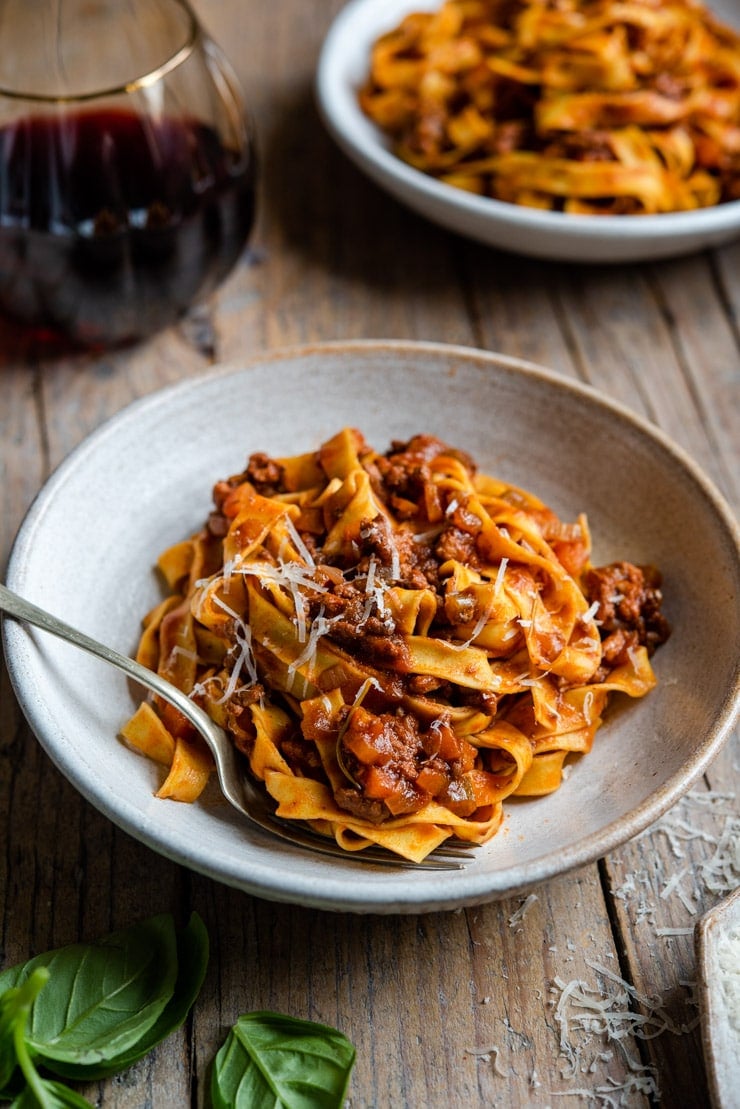
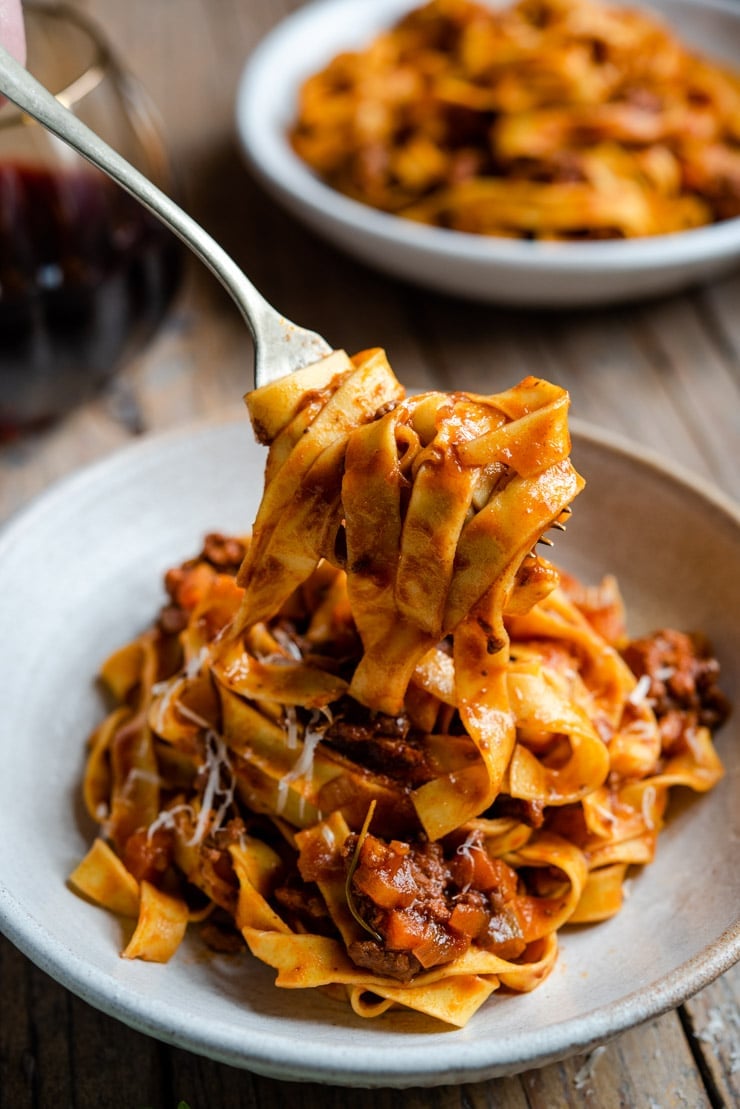
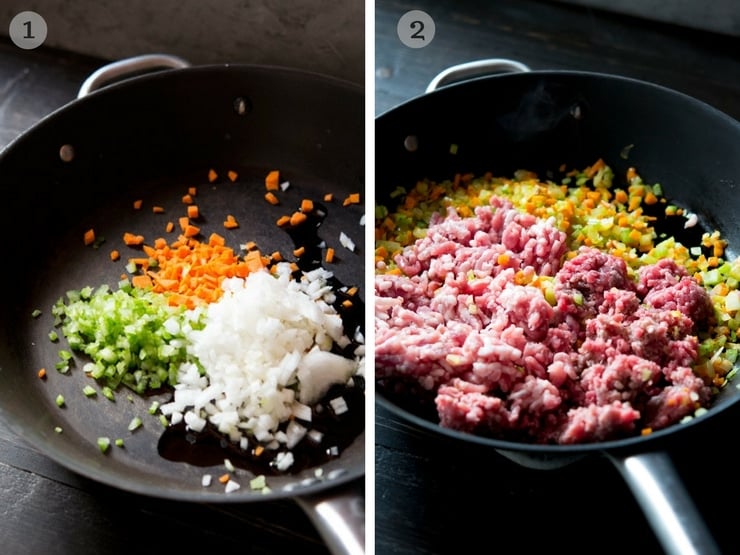
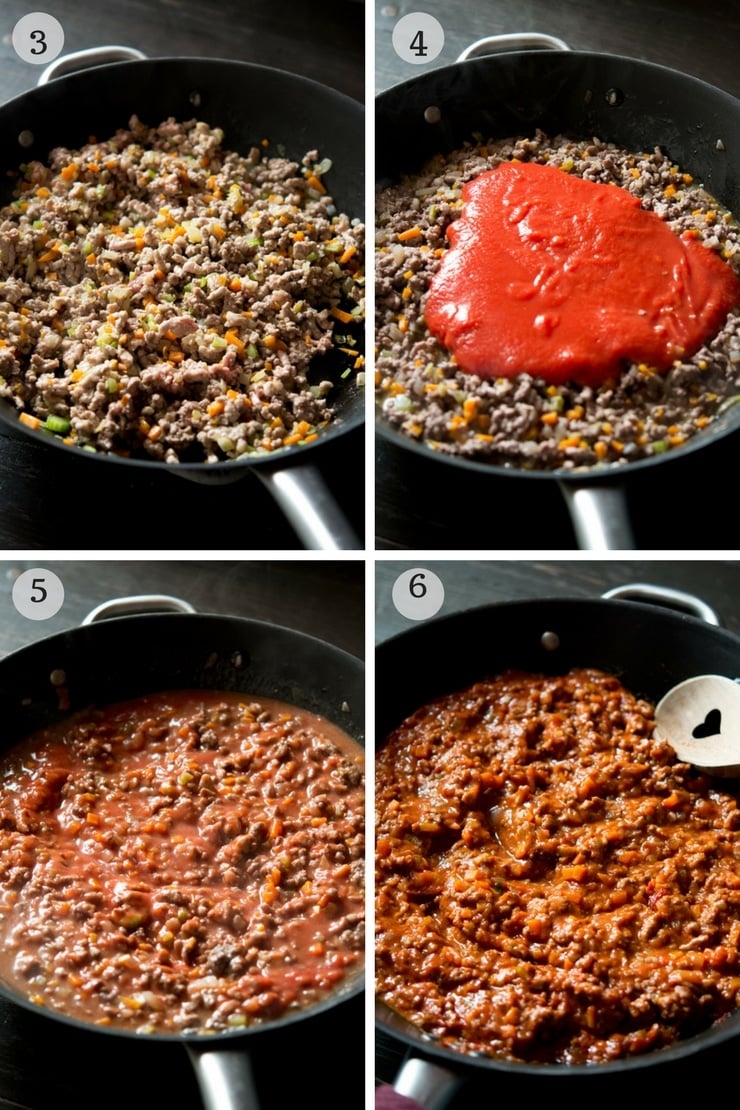
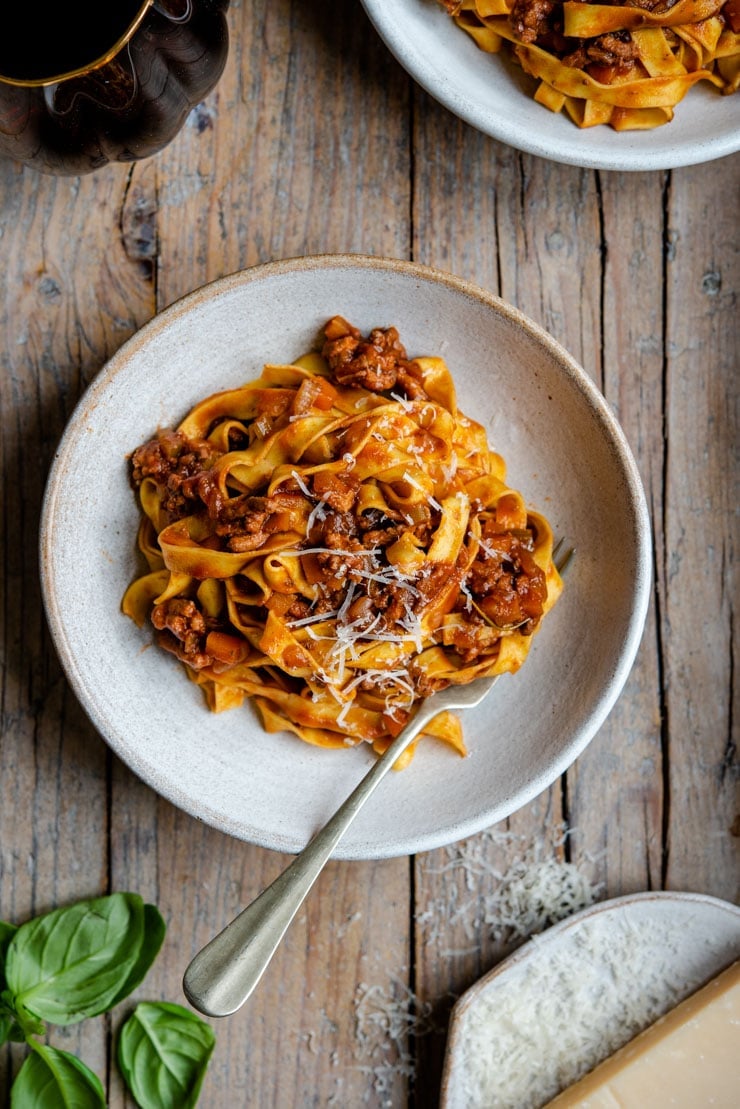
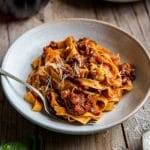
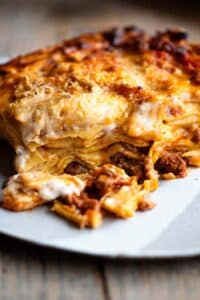

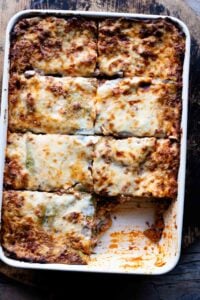
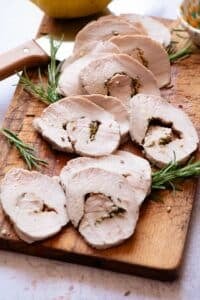
Delilah
I love your recipes! Can’t wait to try this.. Do you think I could beef chuck instead of ground? Would you adjust the cook time?
Thank you so much! Going to hopefully make this weekend!
Emily
Hi Delilah, sorry for the late reply. Yes, you can use beef chuck instead of ground (I wouldn't use any ground pork in that case just use the chuck). If it's still a little firm at the end of the stated cooking time just use more stock or water and simmer it for longer until it's falling apart, enjoy!
Lisa
Can I add garlic, oregano/basil and chilli flakes?
Emily
Hi Lisa, you can adapt the recipe however you like with different herbs/spices/garlic :-). If using garlic always add it fresh if possible, don't use powder.
Sarah
We just love this ragu...it is so much better after resting a day; and I always freeze some for later also. I always make a double recipe. Do you add the salt/pepper to taste at the end? Thanks so much!
Emily
Hi Sarah, thanks so much for your lovely comment! I agree, most ragus, soups, stews etc taste even better the next day. Yes, it's always worth checking the seasoning at the end and adding salt and pepper as needed 🙂
Karen
Delicious. I did throw a small piece of Parmesan rind in to simmer with it. I couldn’t help it. But I live that this is pretty darned simple all in all! Big Bang for your buck in flavor.
Sarah
Hi, I was looking for a ragu recipe, and google took me here.
I've read other recipes also, and this recipe seems it doesn't have unnecessities and only the core igredients. So I decided to follow this recipe for my first ragu.
But the problem is I don't have beef stock and it's hard to get or make it.
Is it ok to use water or chickin stock instead beef stock?
Emily
Hi Sarah, if you don’t have beef stock I’d use chicken stock instead it’ll give you better flavour than just water. Enjoy!
Sarah
Thank you for your reply:D
I found so many typos in my first comment.
Sorry for that.
However, I'm so excited to make ragu! Thank you:)
Charlotte
I have always struggled making a meat sauce that tasted like anything. THIS was different and I appreciate the lesson... It. Takes. Time. By happy accident, I ran out of my usual beef broth last night when I was making this. I had enough for the initial sauce, but not once it started to reduce, so was left with using water. I borrowed some from my neighbor and it had gone off (glad I checked!), so I had to wait until this afternoon to go buy more and finish the sauce. It was outstanding! Looking forward to making it again.
Andee
Emily,
Could I add sliced mushrooms to this Ragu and could I add them to the carrots, celery and onion mixture?
Emily
Yes, no problem, add them with the other vegetables! 🙂
Charé
Hi Emily! May I ask what your thoughts are in terms of making this for 50 people? Also, how much of pasta would you suggest I make per 6 people serving? I want to make the pasta from scratch (using a egg dough) but I also want to make it ahead of time and freeze it.
Heather
Can I use a shredded beef?
Suz
I make this for the family 1-2 times a month. Great for make ahead dinners that my husband can reheat for the kids before I get home. The recipe is always a hit- for kids & parents alike! Thank you!
John
I used Italian hot sausage. Removed meat from casings and combined with ground beef. It came out very tasty.
Iris Meffan
Just wondering is it's essential that you use 50/50 pork and beef or if just beef would be fine?
Emily
Hi Iris, yes you can use 100% beef instead. The reason for the pork meat is because it's much fattier than beef so adds extra flavour and moisture.
Sheenagh Gardner
This is the best recipe ever. My family loved it and now they all want a copy.
Lesley Horrocks
Loved this ragu .
Emily
So happy you enjoyed it!
Joey
This is essentially a recipe of Bolognese sauce. Ragu is made with large pieces of meat and no carrots or celery.
I grew up in Italy
Emily
Hi Joey, Ragu alla Bolognese or Bolognese sauce is actually very different from this recipe, it's made with pancetta and milk. You can find the official recipe of Bologna here. Ragu can be made with larger pieces of meat or ground meat but they almost always include Il Soffritto (carrot, celery & onion) it's actually a really important part but of course there are exceptions. I can assure you this is a classic recipe for ragu.
Anna
Love your recipes and easy to follow instructions
Emily
Thank you so much!
Tuittu
So good.
Thank for recipe.
I Will do this again.
Even my Italian boyfriends liked, so my points get up 😉
Eve
This ragu is simply amazing!
Jan Veale
Excellent Ragu,just the right balance of ingredients
Julie Russell
I tried it and loved it! I do not know if I can ever go back to plain old spaghetti from a jar again 🙂
Gloria Martino
Bravo authentic delicious recipe
added links of italian sausage one sweet one hot (out of casings) little different flavor
we love it both ways
Thank you so much
Gloria Martino
Emily
Great idea, sounds so delicious. So happy you enjoyed it!
sarah Johnson
This is very similar to how I cook it, except I add a clove of garlic and herbs. Is that not authentic Italian?